Divorce Rate Statistics
Getting a divorce signifies the end of a marriage. It can have drastic impacts on you and your spouse, as well as any children you share. While divorce isn’t always preventable, it helps to understand potential risks that may increase your chances of a divorce. Explore key divorce rate statistics, including the prevalence and common reasons for divorce, in this guide from The Law Offices of Travis R. Walker, P.A.

Your wedding vows may have included a promise to stay together through thick and thin until the end of your lives. However, time can change many things, including your relationship with your spouse. Disagreements over money, parenting responsibilities, or simply growing apart can all lead to the dissolution of a marriage.
The Law Offices of Travis R. Walker, P.A. offers this exploration into divorce rate statistics throughout the U.S. Learn the top reasons for divorce, current divorce rates, and a few tips for strengthening your marriage.

How Often Does Divorce Occur in the US?
The most recent report from the Centers for Disease Control and Prevention found that 1,985,072 marriages occurred in 2021, for an overall marriage rate of 6.0 for every 1,000 people. There were 689,308 divorces during the same period, with a rate of 2.5 per 1,000 individuals. The report included data from 45 states and Washington, D.C.
Has Divorce Increased or Decreased in Recent Years?
In 2000, the divorce rate was 4.0 per 1,000 people. Since then, it’s steadily decreased nearly every year to its current rate of 2.5 per 1,000 individuals. There was a slight increase in divorce during the coronavirus pandemic, but rates are expected to hold steady or continue to decline in future years.
What Are the Top Reasons for Divorce?
A study of divorced individuals cited multiple reasons contributing to their decision to divorce. Some of the most common factors include:
Lack of Commitment
As time passes, couples may become overly comfortable with one another. The affection and commitment present at the beginning of the relationship may begin to fray. Traumatic experiences during the relationship may further increase the lack of commitment from both partners.

Domestic Violence
Sadly, not every marriage is free from violence. Both partners may use physical or emotional abuse to control the other’s actions. Abuse typically occurs in cycles, and if the abuser doesn’t change their ways, it may lead to a divorce.
Infidelity
Inattention to a partner’s needs or temptation to stray from a marital relationship may instigate a divorce. According to the study, 31.3 percent of divorced couples agreed that infidelity was a cause of their divorce, while 59.6 percent of individual partners said it was a big reason for the separation.
Substance Abuse
Substance abuse issues, including alcohol, drug, and pharmaceutical abuse, can lead to divorce. The substance abuser may attempt to get hold of their issue, but the risk of divorce increases after several failed efforts to control drinking or drug use.
Financial Issues
Finances can cause lots of disagreements in a marriage. Partners may disagree on the household budget, spending, or significant purchases. Per the study results, over 50 percent of partners in a divorce agree that financial issues ultimately led to their separation.
Which States Have the Highest Divorce Rate?
When it comes to divorce, where you live can impact your marriage’s long-term success. Nevada’s divorce rate of 4.2 per 1,000 people is the highest of all states, followed by Oklahoma with a divorce rate of 3.8. Other states with divorce rates of 3.4 or higher include Alabama, Arkansas, Florida, Idaho, and Wyoming.
Nevada’s high divorce rates are likely due to the state’s relaxed marriage laws. People working in the gaming industry, including casinos, typically have higher rates of divorce than other occupations. The Nevada divorce rate has been much higher than other states for several decades.
Massachusetts has the lowest divorce rate of 1.0. Other states with lower divorce rates include Illinois, Maryland, and Texas.
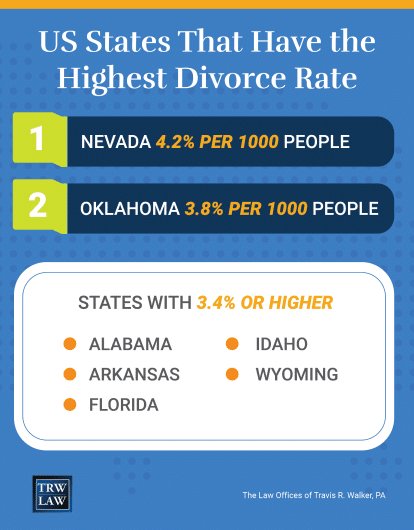
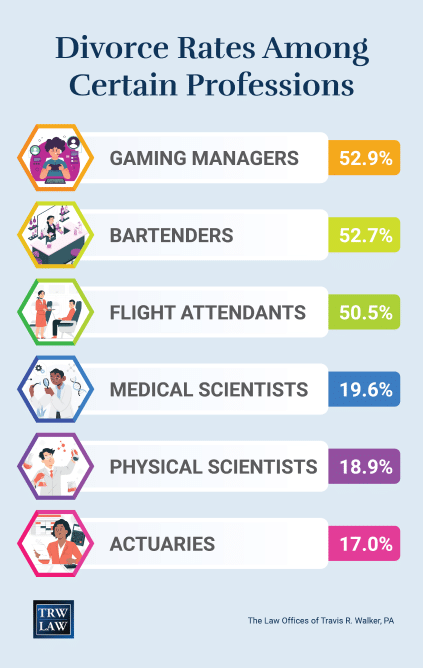
What Occupations Have the Highest Divorce Rates?
Your job may impact the longevity of your marital union. Individuals in the hospitality industry, including bartenders, gaming managers, flight attendants, and massage therapists, have higher divorce rates than other occupations. Frequent interaction with customers in a casual environment, plus long hours, may increase their risk of divorce.
Interestingly, insurance actuaries have the lowest divorce rates. Other occupations with low divorce rates include physical and medical scientists, optometrists, podiatrists, software developers, and engineers.
The divorce rates among certain professions include the following:
- Gaming managers: 52.9 percent
- Bartenders: 52.7 percent
- Flight attendants: 50.5 percent
- Medical scientists: 19.6 percent
- Physical scientists: 18.9 percent
- Actuaries: 17.0 percent
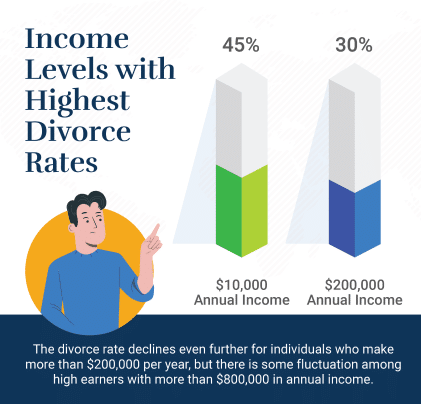
What Income Levels Have the Highest Divorce Rates?
Individuals earning less than $10,000 in annual income have the highest divorce rate—close to 45 percent. However, divorce rates decrease sharply as income increases, leveling off at 30 percent among individuals earning $200,000.
The divorce rate declines even further for individuals who make more than $200,000 per year, but there is some fluctuation among high earners with more than $800,000 in annual income.
The higher your income, the less risk of divorce in general. However, couples in the top earning brackets may experience different relationship complications that can result in divorce.

Does Having Children Impact the Divorce Rate?
The overwhelming majority of children live with both of their parents—approximately 70 percent. However, the rate has dropped since 1968, when 85 percent of children lived in two-parent households.
Children who live only with their mothers account for 21 percent of households, up from 11 percent in 1968. Approximately 4.5 percent of children live with only their fathers, an increase from 1 percent in the late 1960s.
Just 4 percent of children live without either parent. In those cases, 55 percent live in a household with a grandparent.
Divorce Rates by Age
Marrying before the age of 25 comes with a greater risk of divorce. That’s no surprise, as younger partners may lack the maturity and communication skills to make a marriage work.
People who marry between the ages of 25 and 32 have higher marriage success rates. They may be more financially secure by that point and have developed the maturity necessary to deal with common marital issues.
However, after 32, the risk of divorce increases incrementally every year. Interestingly, first-time marriages that occur in an individual’s 40s or 50s are at higher risk of divorce. That may be because partners are quite used to the single life and struggle to deal with issues that may arise in a partnership.
Divorce Rates by Gender
Women initiate approximately 69 percent of divorces. They may take more of the mental load in a relationship, and frustration over marital problems may lead them to file for divorce.
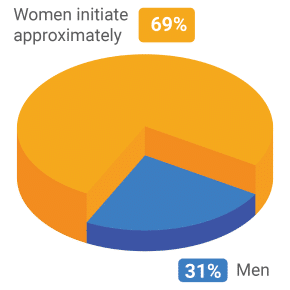
Divorce Rates by Ethnicity
Even your ethnicity can play a factor in the success of your marriage. Here are the divorce rates per 1,000 people for different ethnicities:
- Asian, American Indian, Alaska Native, and multiracial: 12.4
- White: 15.1
- Hispanic: 18.5 percent
- Black: 30.8 percent.
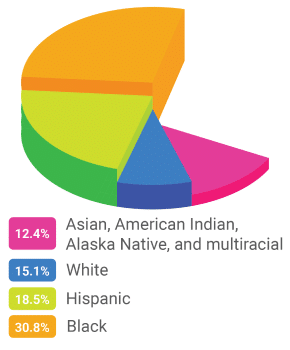
Divorce Rates by Education Level
Individuals with high levels of education generally have a lower risk of divorce. The divorce rate for individuals with a high school education is 45.3 percent, and those who went on to get a bachelor’s degree have an average divorce rate of 25.9 percent.
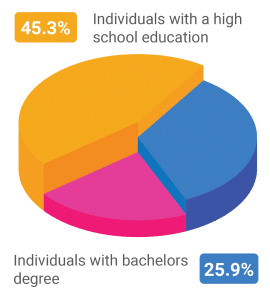
Tips for Having a Successful Marriage
Divorce rate statistics help shed some light on risk factors that can increase the chances of divorce, but every couple is different. You can mitigate your risk of divorce by following a few tips.
Build Good Communication Skills
Couples can argue about all kinds of things, leading to fractures in their marital relationship. Work on understanding each other’s communication styles and working toward favorable resolutions.
Put in the Effort for a Strong Relationship
Over time, your and your partner’s interests will likely change. Work on exploring new things together and be willing to expand your horizons. Shared values are the glue of a relationship. Even if your partner’s taste in music or TV shows changes over time, a commitment to each other can help you maintain a long-lasting relationship.
Consider Marital Counseling
If you notice increased fights and disagreements that you can’t seem to resolve, seek help from a professional. A marriage counselor can help you address marital issues before they overtake your relationship.








